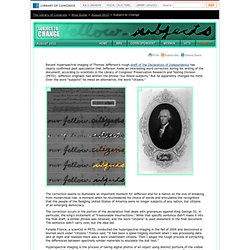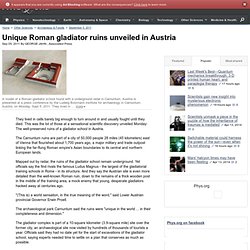

The Seven Wonders of the World. Famous & Major Historical Events in World History. Www.timeref.org. The Wise Guide : Subject to Change. Recent hyperspectral imaging of Thomas Jefferson’s rough draft of the Declaration of Independence has clearly confirmed past speculation that Jefferson made an interesting word correction during his writing of the document, according to scientists in the Library of Congress’ Preservation Research and Testing Division (PRTD).

Jefferson originally had written the phrase “our fellow-subjects.” But he apparently changed his mind. Over the word “subjects” he inked an alternative, the word “citizens.” The correction seems to illuminate an important moment for Jefferson and for a nation on the eve of breaking from monarchical rule: a moment when he reconsidered his choice of words and articulated the recognition that the people of the fledgling United States of America were no longer subjects of any nation, but citizens of an emerging democracy. Fenella France, a scientist in PRTD, conducted the hyperspectral imaging in the fall of 2009 and discovered a blurred word under “citizens.” Simeon Stylites. Saint Simeon Stylites or Symeon the Stylite (Classical Syriac: ܫܡܥܘܢ ܕܐܣܛܘܢܐ šamʻun dasṯonáyá, Ancient Greek: Συμεὼν ὁ στυλίτης Symeon Stylites Arabic: سمعان العمودي semaan al aamoudi ) (c. 388 – 2 September 459) was a Christian ascetic saint who achieved fame for living 37 years on a small platform on top of a pillar near Aleppo in Syria.

Several other stylites later followed his model (the Greek word style means pillar). He is known formally as Saint Simeon Stylites the Elder to distinguish him from Simeon Stylites the Younger and Simeon Stylites III. Early life[edit] Simeon was the son of a shepherd.[2] He was born at Sis, now the Turkish town of Kozan in Adana Province. Sis was in the Roman province of Cilicia, and after the separation of the Roman Empire in 395 it became part of the Eastern Roman Empire and Christianity grew quickly there. According to Theodoret, Bishop of Cyrrhus, Simeon developed a zeal for Christianity at the age of 13, following a reading of the Beatitudes. Freer Sackler Galleries. Unique Roman gladiator ruins unveiled in Austria. They lived in cells barely big enough to turn around in and usually fought until they died.

This was the lot of those at a sensational scientific discovery unveiled Monday: The well-preserved ruins of a gladiator school in Austria. The Carnuntum ruins are part of a city of 50,000 people 28 miles (45 kilometers) east of Vienna that flourished about 1,700 years ago, a major military and trade outpost linking the far-flung Roman empire's Asian boundaries to its central and northern European lands.
Mapped out by radar, the ruins of the gladiator school remain underground. Yet officials say the find rivals the famous Ludus Magnus - the largest of the gladiatorial training schools in Rome - in its structure. And they say the Austrian site is even more detailed than the well-known Roman ruin, down to the remains of a thick wooden post in the middle of the training area, a mock enemy that young, desperate gladiators hacked away at centuries ago. It was definitely a school of hard knocks.